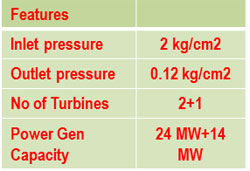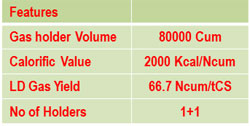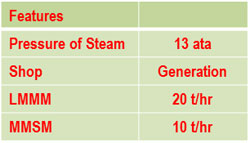
Coke Dry Quenching Plant
- Conventionally, after pushing from the coke oven, this high temperature coke was quenched by water sprinkling and its sensible heat was diffused into the atmosphere.
- RINL has four coke oven batteries of 7 meter tall ovens to produce coke with coke dry quenching facility.
- The hot coke from the coke oven is cooled by counter-current circulating nitrogen gas in a closed circuit consisting of a cooling chamber, dust collecting bunker, a waste heat boiler, dust cyclones, a mill fan, and circulating ducts.
- This system will recover sensible heat of coke. The recovered heat generates steam (4MPa), which is turning used to produce electricity in Back Pressure Turbine station.
- Back pressure steam (2.5ata) is used for production of chilled water in Vapour absorption chillers.
- RINL also installed Condensing and Extraction Turbine (COB4 of 13 MW Cap) to enhance efficiency.
- Coke cooling through CDQ improves coke strength and facilitates in reducing coke consumption in Blast Furnace.
 |
 |
Top Pressure Recovery System
- In conventional blast furnaces, the Blast furnace gas generated as by product in iron making, is cleaned and cooled in Wet Type Precipitator. The Gas pressure is reduced in the Septum Valve (throttle assembly) before sending it to the consumers as low pressure gas for combustion in various furnaces and pressure energy is lost.
- RINL envisaged Top Pressure Recovery Turbine to convert the physical energy of high-pressure blast furnace top gas to generate electricity.
- Blast furnace gas (BFG) has a pressure of 0.2-0.236MPa (2-2.41 kg/cm2) and temperature of approximately 200OC at the furnace top.
- The system comprises dust collecting equipment, a gas turbine, and a generator.
- The generated electricity is Green Electricity.
- RINL installed this facility for 2 No of Blast Furnaces for first time in India.
- RINL also installed 14 MW TRT in Blast Furnace-3
- Coke cooling through CDQ improves coke strength and facilitates in reducing coke consumption in Blast Furnace.
 |
 |
LD Gas Recovery System
- Liquid steel is produced by the converter process.
- The raw material used in the converter is mainly hot metal, scrap and other Ferro alloys.
- The converter decarburizes the carbon in the hot metal using pure oxygen.
- During the blowing process, high temperature gas (CO) with a heating value of approximately 2,000 kcal/Nm3 is generated using suppressed combustion method.
- Earlier systems, the gas cannot be recovered.
- The recovered gas is stored in LD Gas holder and used as fuel in reheating furnaces.
- RINL also installed similar capacity Gas Holder (80000 Cum) in Steel Melting Shop
 |
 |
Rolling Mills Evaporative Cooling System
- The reheating furnaces are mainly of walking beam and walking hearth type.
- The furnace elements such as doors, lintels and skid and posts are cooled by water and the hot water goes to the cooling tower and after cooling returns for cooling furnace elements.
- In some systems, the furnace skids and posts are cooled by demineralised water and the cooling energy is recovered as process steam using evaporative cooling system.
- In this system, the feed water from feed water plant passes through furnace skids and posts and the water converted in to steam goes to steam drum.
- The process steam generated will be used either internally or sent to process steam network.
- The reheating furnaces at Light and Medium Merchant Mill(LMMM) and and Medium Merchant and Structural Mill(MMSM)are equipped with this system.
- Usage of process steam reduces steam demand from captive power plant and reduce GHG emissions.
 |
 |